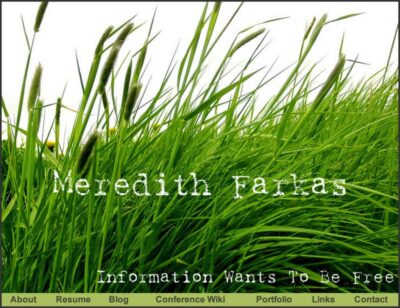Where I got my MLIS, distance learners had to pay more per credit hour than students who took classes on campus. I understood that the extra fees paid for the technology infrastructure we used. On the other hand, we distance learners missed out on many of the things that tuition goes towards. I couldn’t go for free visits at the student health center. I couldn’t use the gym. But worst of all, I couldn’t visit the library. Luckily my school allowed distance learners to get books mailed to their home and had a reciprocal borrowing agreement with other Florida Universities, so I could get books if I needed them. They also offered virtual reference services through a chat cooperative of Southeastern Universities. But this was never made clear to anyone in my distance learning classes and it was not mentioned anywhere on Blackboard. There was a small icon on the library’s homepage (saying “distance learners”) that led to a page briefly describing services to distance learners, but the connection between distance education and the library was tenuous at best. You could tell that the people who were designing the distance learning courseware and the librarians were not really working together.
But this was a far better situation than at some other schools. Some institutions that offer distance education do not have a web page on their site that describes what services distance learners are entitled to. (By the way, here is a great example of an effective website for informing distance students about the services they are entitled to). Many students don’t know that they can get books mailed to them. If schools don’t publicize the availability of special services for distance learners, it is just as bad as not offering them at all. Some schools that offer distance programs don’t have synchronous virtual reference, so a student must either send an email or incur the cost of a long-distance phone call. A student is not going to want to send an email if they have a question that needs to be answered in a timely manner. And it is unfair to ask a student — who is paying plenty of tuition already — to pay to call the reference desk. Given those choices, many students will probably just give up and try Google. And who could blame them?
At one school where I interviewed a while back, I was told that the school’s distance learning program had taken the library by surprise. There really wasn’t much communication between the people developing distance learning programming and courseware and the people running the library. As a result, they had a hard time anticipating the needs of the distance learners. It took them a while before they even started mailing books to students. I don’t know whether distance learning has taken other libraries by surprise, but it seems like a lot of them have some catching up to do. They by no means are providing equivalent services to distance learners.
Here’s an excerpt from the ALA Guidelines for Distance Learning Library Services:
Services
The library services offered to the distance learning community should be designed to meet effectively a wide range of informational, bibliographic, and user needs. The exact combination of central and site staffing for distance learning library services will differ from institution to institution. The following, though not necessarily exhaustive, are essential:
1. reference assistance;
2. computer-based bibliographic and informational services;
3. reliable, rapid, secure access to institutional and other networks, including the Internet;
4. consultation services;
5. a program of library user instruction designed to instill independent and effective information literacy skills while specifically meeting the learner-support needs of the distance learning community;
6. assistance with and instruction in the use of nonprint media and equipment;
7. reciprocal or contractual borrowing, or interlibrary loan services using broadest application of fair use of copyrighted materials;
8. prompt document delivery, such as a courier system and/or electronic transmission;
9. access to reserve materials in accordance with copyright fair use policies;
10. adequate service hours for optimum access by users; and
11. promotion of library services to the distance learning community, including documented and updated policies, regulations and procedures for systematic development, and management of information resources.
I know of few libraries that can claim to offer all of those 11 services to distance learners, though there are some. If you work at a library that offers all of those services to distance learners, I’d love to hear about it. Email me!
A few months ago, an interesting study came out the level of support ARL libraries provide for distance learners:
Yang, ZY. Distance education librarians in the U.S. ARL libraries and library services provided to their distance users. The Journal of Academic Librarianship, Volume 31, Issue 2, March 2005, Pages 92-97.
The study found that only about half of the libraries surveyed had a designated distance learning librarian. Paul Pival, The Distant Librarian, discusses the article and includes some interesting excerpts.
Distance learners should be entitled to equivalent services as on-campus students. Where they cannot meet with a reference librarian in person, they should be able to communicate with one in real time, whether it be through Jybe, Skype, IM, 1-800 number or one of the for-pay virtual reference software options. Where they cannot attend workshops on how to use databases, there should be screencasts available that teach the same skills. Every institution can provide equivalent services to distance learners, but it takes committment, creativity and tech-savvy to make it happen.




I agree. I’m currently working on possibilities for our distance site to be updated as well. We tend to be a bit lucky in the regards you’ve listed as we’re the library, distance, and tech support for online courses all in one so we have an advantage. Unfortunately I think we have quite a bit to go in terms of our presence. We accept 800, phone and email right now. I’m looking into options such as IM and Skype. I think many universities pushed their programs online but didn’t push the support to be there. I’m hoping to work on things soon. If I come up with anything I’ll be sure to pass it along.
I am working as a librarian in a government college in kerala. presently i have undertaken research in Distance education and library support services in the state of kerala in india. The particular thing is that the mode of distance education in this state is even now the old correspondance education. But we can serve the people in the remote areas of the villages in india only by that method. However we are gradually getting developed into the area of internet communication and all. I would like to publish my e-mail ID so that I can have suggestions from people like you in tjis regard to carry on with my study.
great that professionals like you are weel ahead of us.
Distance Education library services, by concept it is okay that we can reach the people who are on one side of the digital divide. Think of the deprived ones. How well we can reach them ? This question will remain for along time ?
My e-mail id is
gopakumar.v@rediffmail.com